 |
 |
| Home | Welcome | What's New | Site Map | Glossary | Weather Doctor Amazon Store | Book Store | Accolades | Email Us |
 | ||||||||||||||||||||||
Weather Almanac for February 2010PLAYING THROUGH WINTER ON SNOW AND ICE:
|
||||||||||||||||||||||
 |
 |
Rodoy rock carving of an early skier . |
Our first hard evidence of skis and skiing can be found on rock drawings found in both Rødøy and Steinkjer, Norway, which show figures on skis holding a stick. Some of these have been dated at about 7000 years old. Archeologists have also unearthed a ski in a peat bog located near Hoting in the province of Angermanland, Sweden dated by pollen analysis to be around 4500 years old. This ski measured 111 centimetres (44 inches) long, 9.5 to 10.4 cm (3.7 to 4.2 inches) wide, and ranged in thickness from one centimeter (0.4 in) at the tip to two (0.8 in) cm at the middle. At the thickest width, the ski was hollowed out, likely for foot placement, and holed for primitive bindings. The ski pole likely evolved from the walking stick, such as those used by snowshoers used for balance. Ancient skis found in France and Switzerland have also been dated at about 4000 to 5000 years old. For many millennia, skiing was a means of transportation rather than a recreation. Today we generally refer to this form of skiing as cross-country or nordic skiing.
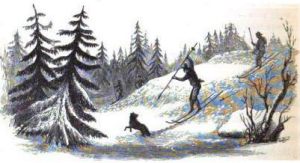 The earliest people, probably distant ancestors of the modern-day Samis, to make extensive use of skis inhabited Fennoscandia (geographic region encompassing the Scandinavian Peninsula, the Kola Peninsula, Karelia and Finland). Skis likely developed as an aid for hunting game during the winter as various rock carvings indicate. (Illustration at right from Scandinavian Adventures By Llewelyn Lloyd, 1854)
The earliest people, probably distant ancestors of the modern-day Samis, to make extensive use of skis inhabited Fennoscandia (geographic region encompassing the Scandinavian Peninsula, the Kola Peninsula, Karelia and Finland). Skis likely developed as an aid for hunting game during the winter as various rock carvings indicate. (Illustration at right from Scandinavian Adventures By Llewelyn Lloyd, 1854)
Norse legends tell of Ullr (or Ull or Ollerus) and Skade (or Skada or Skadi), the god and goddess of skiing. Our word ski originates from the Old Norse word skíð meaning “a split piece of wood or firewood.”
The oral sagas from about 1200 BC mention King Sverre of Norway ordering Pal Belte and other local civilians, who used skis to get around, to spy on enemy positions near Ryenbergene — the earliest record of military use of skis. The Greek historian Xenophon wrote of skis in 400 BC. From then through the first millennium AD, there are frequent mentions of skiing in the Viking Sagas. For example, Egil Skallagrimsson’s saga from 950 AD describes King Haakon Adalsteinsfostre the Good’s practice of sending his tax collectors out on skis.
One early historical incident involving skis occurred in 1206 during the Norwegian civil wars. In 1202, King Sverre Sigurdsson died. His death meant a decrease in power of the Birkebeins, the party comprised mostly of peasants who supported his claim to the throne. When his successor King Haakon Sverresson died but two years later, it left Haakon’s infant son Haakon Haakonsson as a target for the opposing Bagler faction who wished to remove the pretender to the throne and install their man Inge Magnusson.
The infant Haakon then living in Hamar, a town under Bagler control, was in great danger. However, in 1206, a group of the Birkebeiner skiers spirited off the two-year-old Haakon and embarked on a dangerous trek through forests and across treacherous mountains, taking the young king to safety in Lillehammer. After years of strife, Haakon ascended to the throne relatively unopposed in 1217. King Haakon Haakonsson IV, finally ended the civil wars in 1240.
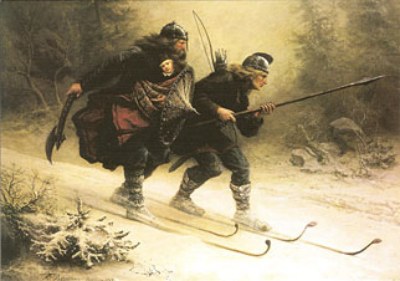
This heroic event is memorialized annually in Norway with the 54-km (34-mi) Birkebeinerne cross-country ski race, named after the birch leggings the skiers wore. The ski event requires racers to carry a backpack weighing 3.5 kg (7.7 lb) as homage to the child the Birkebeiners carried on their journey. The ski event starts today in Rena, Norway and finishes at Lillehammer. Hayward, Wisconsin and Edmonton, Alberta also hold sister races annually.
A similar annual ski marathon is held in Sweden, known as the Vasaloppet, which begins in the village of Sälen and finishes in Mora, Sweden, a distance of 90 km (56 miles). This endurance race commemorates the memory of freedom fighter Gustav Vasa who lead an uprising in 1520 that eventually overthrew Danish rule. Pursued by the Danes, according to legend, Vasa attempted to raise an army against the Danes, but he was forced to flee on skis northwestward toward Norway. After reconsidering Vasa’s proposal, the townsfolk of Mora decided to join the rebellion. Two of Mora’s best skiers were sent to track Vasa down and returned with him to the city where Vasa would organize the rebellion. Three years later, Gustav Vasa’s rebellion overthrew the Danish king Christian and dissolved the Kalmar Union. As a result he was crowned Gustav I, king of Sweden. Sweden has been fully independent ever since.
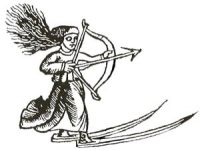 The earliest manuscript (from which illustration at right is taken) completely describing skis and skiing came from the pen of the Swedish ecclesiastic and writer Olaus Magnus. In his tome Historia de Gentibus Septentrionalibus (A History of the Northern Peoples), published in Rome in 1555, he wrote:
The earliest manuscript (from which illustration at right is taken) completely describing skis and skiing came from the pen of the Swedish ecclesiastic and writer Olaus Magnus. In his tome Historia de Gentibus Septentrionalibus (A History of the Northern Peoples), published in Rome in 1555, he wrote:
“…the Inhabitants of it [Scricfinnia] slide very swift, having their feet fastened to crooked pieces of Wood made plain and bent like a bow in the former part, with a staff in their hands to guide them; and by these, at their pleasure they can transport themselves upward, downward, or obliquely, over the tops of snow…”
He continued the discourse by describing how the skiers are able to ascend hills in the days before ski wax and herringbone patterns on ski bottoms:
“they provide that those pieces of wood be covered beneath with the tender skin of a young Fawn, the form and color whereof is like to a Deer Skin but it is far longer and larger. … when they ascend to a place they may not fall backward: because the Hair will rise like Spears, or Hedg-Hog Bristles, and by an admirable power of Nature hinder them from falling down.
Although we don’t know precisely when skiing became a competitive sport, humans have long been competitive, and it likely was not long after their invention that ski racing began. We do know that in the Eddas, a collection of Icelandic poems, the Viking ruler King Harald Hadrade of Iceland indulged in skiing for gambling and winning prizes around 1046-1066. Skiing was also considered a leisure activity for many aristocrats who raced on skis and bet on races.
Gold seekers brought skis to the Sierra Nevada Mountain gold fields in California in 1850, though they were often referred to as “Norwegian snowshoes” rather than as skis. Skiers were used to move the mail around the Sierras beginning in 1856. The most famous was the Norwegian John “Snowshoe” Thompson who actually used large oak-wood skies that were 3 metres (ten feet) long and 10 cm (4 inches) wide at the front where they turned up and weighed 11.3 kg (25 lb). He carried a single pole, which he generally held in both hands at once like a high-wire performer, or placed between his legs as a brake. There is documentation as early as 1767, of “professional” skiing competitions held in Norway, which likely meant competition among members of military ski regiments, and they may have included biathlon (skiing and marksmanship) and downhill races. The first major organized “open” ski racing competition took place in Tromsø Norway, in 1843. Finland’s first major ski competition was held in 1865, though likely other, smaller, race competitions were held earlier. The first major timed race occurred in northern Sweden in 1884 and covered 220 kilometres (137.5 miles) in two stages. (Lars Tuorda from Lapland won that race in 22 hours and 22 minutes.) |
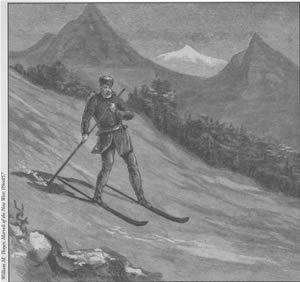 Norwegian John “Snowshoe” Thompson used large oak-wood skies to deliver the mail across the Sierra Nevadas. |
The gold-seeking 49ers organized the first ski clubs and competitions in North America. Newspaper records indicate downhill ski racing took place in California's gold-mining camps as early as 1854 between competing mining camps. These races reached their peak popularity in 1869. The ski equipment was nothing like that of today and likely used skis similar to Thompson’s with the single pole for balance and speed control.
Because of the strong association of Scandinavia with early of skiing, what I refer to as cross-country skiing, it is called nordic skiing to distinguish it from the other main forms of skiing, alpine skiing, aka downhill skiing, and ski mountaineering. (Some consider cross-country skiing only as one type of nordic skiing, the other being Telemark skiing; some also consider ski jumping part of nordic skiing.) In recent decades, basic skiing has had further offspring, namely free-style skiing and snowboarding.
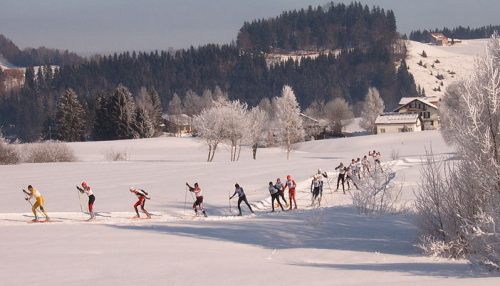 |
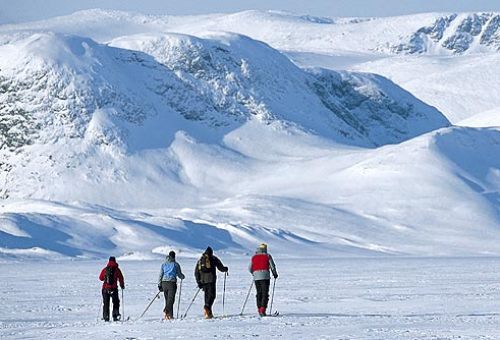 |
Cross-country skiing on Schwedentritt loppet, |
Cross-country skiing in Norway |
The first mention of downhill skiing came in the 1689 publication by the Austrian Baron of Valasavor: Die Ehre des Herzogtumes Krain. In it, he writes of skiers in Slovenia in the Adriatic using shorter (5-foot) skis in order to turn on steep slopes.
The evolution of skis from straight-sided wooden planks equipped with unstable toe-strap or heel-strap leather bindings to a more maneuverable stiff binding capable of fast turns has been attributed to a Norwegian potato farmer named Sondre Norheim. Often called the “father of modern skiing,” Norheim in 1850 developed a heel strap he fashioned from tough, woven, elastic birch-root tendrils that helped to hold the foot firmly to the ski. This stiff binding gave the skier more control, essentially tying the boot more tightly to the ski so that they worked together. He combined this with shorter, more flexible curved skis in 1870. Using this new equipment, he skied to victory in the first Norwegian downhill skiing competition at the age of 43. Norheim and his skiing buddies from Norway’s Telemark region used this new equipment to develop new skiing techniques that became known as the stem, Christiania and Telemark maneuvers for turning as well as the Christiania skidded stop turn.
The first Nordic Games held in 1893 at Christiania — now Oslo — Norway included skiing competitions — long-distance skiing and ski jumping on the now-famous Holmenkollen hill. That same year, the first Central European long-distance ski races were held in Mürzzuschlag, Austria and Jilemnice, Czechoslovakia.
Late in the 19th Century, a change in focus for the sport was beginning in the European mountains. Lead by the British, skiers, upon mastering the Telemark, the Christiania and the stem techniques now turned to fast steep-terrain descents for sport. This led to the first alpine ski racing at the turn of the century with the “downhill” and the “slalom” as the initial events.
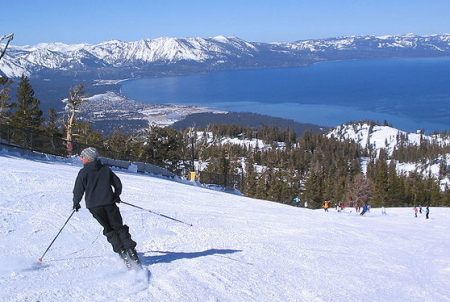 |
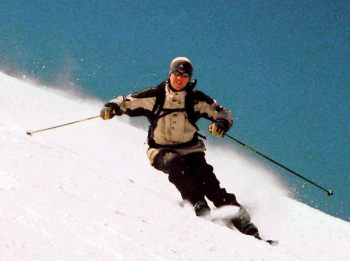 |
Alpine skier at Lake Tahoe, California |
Alpine skier carving a turn |
The first major alpine event was the Roberts of Kandahar Challenge Cup, contested in 1911 at Montana, Switzerland. In this event, competitors skied against the clock down an unmarked course on the Plaine Morte Glacier. The course ran over rough snow and contained enough natural hazards to prevent contestants from simply running straight down, and thus competitors were required to utilize various turning maneuvers.
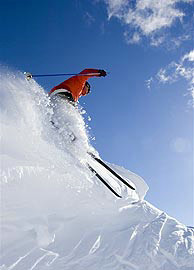 Chamonix, France hosted the first Olympic Winter Games in 1924. Several skiing events were part of those Games: cross-country (nordic) ski races (at 18 and 50 km for men), ski-jumping and the nordic combined (nordic ski racing and jumping). Norwegians won all but two of the twelve medals awarded. As the Olympiads went by, more skiing events were added. Alpine skiing was introduced in 1936 at the Garmisch--Partenkirchen (Germany) Olympic Winter Games, and biathlon (cross-country skiing and marksmanship in a single race) began in 1960 at the Squall Valley, California Games. Freestyle skiing events began in 1992 at Albertville, France. Snowboarding began the following Olympiad (1998) in Nagano, Japan. The docket for the Vancouver Olympics lists 44 events in various forms of skiing for both men and women, plus six snowboarding events.
Chamonix, France hosted the first Olympic Winter Games in 1924. Several skiing events were part of those Games: cross-country (nordic) ski races (at 18 and 50 km for men), ski-jumping and the nordic combined (nordic ski racing and jumping). Norwegians won all but two of the twelve medals awarded. As the Olympiads went by, more skiing events were added. Alpine skiing was introduced in 1936 at the Garmisch--Partenkirchen (Germany) Olympic Winter Games, and biathlon (cross-country skiing and marksmanship in a single race) began in 1960 at the Squall Valley, California Games. Freestyle skiing events began in 1992 at Albertville, France. Snowboarding began the following Olympiad (1998) in Nagano, Japan. The docket for the Vancouver Olympics lists 44 events in various forms of skiing for both men and women, plus six snowboarding events.
 |
To Purchase Notecard, |
Now Available! Order Today! | |
 |
 |
Now |
The BC Weather Book: |


